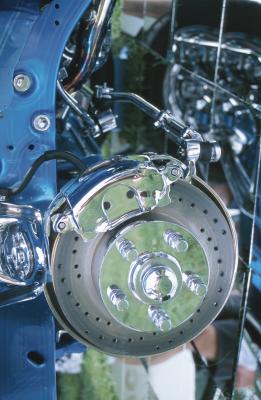
Brake calipers are a crucial part of the braking system of any vehicle, as they perform the mechanical aspect of the braking action. Properly understanding brake calipers, their function and operation, helps you to identify issues when the brakes do not work correctly. While basic information can provide you insight into the braking system and the calipers, without previous experience performing mechanical repairs on your vehicle, it is best to take your car to a mechanic when it comes to repairs or problems with the brakes and calipers.
The brake caliper acts like a clamp on the wheel's rotor to stop the wheel from turning when the brakes are applied. Pressing the brake pedal activates a push rod that pushes against a master cylinder piston that forces fluid into a pressure chamber and throughout the hydraulic brake hose system. The fluid forced through the hydraulic brake lines arrives at the calipers where it acts upon the caliper pistons sealed by O-rings. The O-rings prevent fluid from escaping the system. The caliper piston presses against the brake pads on either side of the rotor, which squeezes or "grabs" the rotor to slow it down. The brake pads use friction to stop the rolling car and are essential for safe stopping to prevent accidents.
Most brake calipers consist of aluminum, as aluminum is very strong, but a light material that can handle the constant wear that exists in the braking system. Minimizing weight is crucial to the design of any vehicle and using forged or cast aluminum brake calipers helps accomplish this goal. Sometimes magnesium alloy is used, but it is expensive and often reserved for race cars. The brake rotors are made of a harder metal, as the friction against the rotor face during braking can bend or warp lighter metals.
Brake calipers can be one or two pieces and contain pistons or cylinders made of aluminum or steel. Two-piece designs are less expensive to manufacture, but have some disadvantages, which includes flex, less present in one-piece designs. Brake calipers hold the brake pads and have channels that accept the hydraulic brake fluid that activates the piston to push the brake pad against the rotor.
Vehicle brakes don't function correctly, if air is introduced into the hydraulic fluid system, if the system leaks brake fluid, the brake pads are worn beyond safe use or if there is a significant amount of debris preventing the piston from moving the brake pad in place to stop. Replace or repair worn brake calipers, but new brake calipers can be expensive, so when possible, have them repaired. Most vehicles will exhibit a warning light or will pull in a particular direction, if there is an issue with your brake calipers.